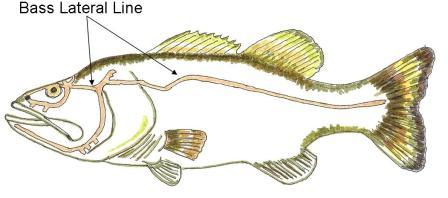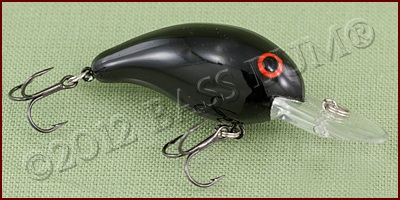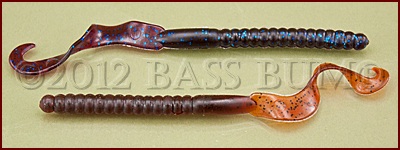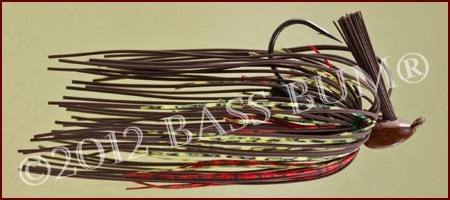The Bass Lateral Line and Vibrating Lures
How do bass react to vibrating lures?
The bass lateral line is a row of pores that run along the sides of the fish from its gills to its tail. This line is filled with water and nerve endings that are finely tuned to any water displacement (disturbance or changes in water motion) and helps bass, in conjunction with its hearing, bass determine if the vibration comes from prey or a predator, how close it is, how big it is and even in which direction it is moving, depending on how close the origin of the movement is to the bass.

The lateral line is tuned naturally to detect the subtle low-frequency (1-80 cycles)vibrations created by small prey such as minnows. It is an ear of sorts that detects vibrations resulting from water displacement. This detection can occur at a significant distance if background noise is at a minimum. Bass associate specific sound wave patterns with specific prey. A bass would not confuse the water movement of your cell phone falling from your shirt into the water with that of a school of shad or even a single jumping shad.
Vibration is most important when water conditions limit visibility, after all, a bass is first and foremost a sight feeder. Beyond four or five feet the hearing of the bass is much more important. However, a vibration occurring within, say five body lengths of the bass, may well arouse its attention and move it to investigate the source to see if it's a meal. From such a short distance the lateral line is deadly accurate and explains in part why even blind bass are able to feed and survive.
So it can be said that the bass lateral line, while playing an important role in feeding, especially in situations where sight distance is reduced as in muddy water, is rarely the single determining factor as to whether a bass strikes bass fishing lures or prey beyond an area close to its body. The lateral line aids in the detection of water movement, arouses the bass' attention and helps guide it closer to its origin where it can then see if it is food and strike.
The bass lateral line sensory system, which is directional, along with the inner ear, which is not, make it easy for a bass to pick up vibrations from lures like crankbaits. For example, a rattle bait moving toward a bass from 40-50 feet away emits from its rattling shot and hooks high frequency sound waves. The inner ear of the bass receives these sound waves but is unable to determine exactly from which direction they come. The lower frequency vibration from the wobble of the lure, that is "pressure waves", are felt (heard) by its lateral line providing the bass with a direction from whence it came.
Even if the water movement detected is soft like that emitted by "quiet" soft plastic lures such as plastic worms, lizards or plastic grubs bumping rocks or stumps the bass lateral line sensitivity even alerts the bass to these and the possibility of a meal. These soft lures probably more closely resemble the sounds and vibrations made by natural prey than do crankbaits or other hard plastic lures.
In both cases the bass will be aware something is "out there" via its hearing and lateral line but it probably does not consider it to be significant. As vibrating lures or even those that are "quiet" come closer the vibration and sound reach the transition stage where both are strongly received and the fish combines its sight, hearing and lateral line to determine the location, direction and identity of the lure.

Bass Fishing Lures and the Bass Lateral Line
Why do bass strike baits that have make sounds, create vibrations and have shapes unlike anything they have seen in there natural world?
A spinnerbait certainly is unlike anything a bass might see in its water world. A plastic worm is a reproduction of a non-aquatic creature. What about all the "creature baits" available to anglers today? Some look as if they came from another planet!
There are several reasons bass attack an artificial lure: hunger, instinct, curiosity, anger, reflex, gluttony or territorial aggression. Three are the most likely, curiosity, instinctual aggression and hunger.
Curiosity: Bass are naturally curious, especially the smallmouth bass. Anything new that appears in their environment or any new new sound alone or associated with the new entity, draws irresistibly on their natural curiosity. Not having hands they will use their mouths to tell them if it may be an item for dinner. That is when they often "take the hook".
Instinctual Aggression: Bass are very "pugnacious piscatores" with little tolerance for intruders. This aggression is often the reason a bass is hooked on an acoustic lure as they may be particularly irritating to them.
Hunger: As a predator the bass is tuned to the sounds its various prey make, sounds that clue the bass that it is food. Numerous artificial baits that catch bass emit sound and vibration patterns reflective of those made by their natural prey.

Hardbaits, Soft Plastic, Spinnerbaits, Jigs and the Bass Lateral Line

Hardbaits that vibrate don't always fall completely within the sound range made by natural prey as they produce sounds and vibrations across the spectrum of frequencies a bass can hear. During retrieve some portion of its sound will fall within a bass' range of hearing. Note that the sound, as heard by bass, differs during the retrieve depending on depth of water and hardness of the bottom.

Soft plastic lures create sounds and vibrations as they are retrieved along the bottom, bumping over rocks, stumps and trees that are much closer to those naturally made by bass prey and therefore tend to be better bass catchers when properly presented.

Jigs with rattles are great bass catchers as they look like crawfish as you drag them across the bottom bumping rocks and giving off vibrations that mimic the clicking sounds of crawfish.
Bottom line, both natural or unnatural sounds/vibrations reaching the bass lateral line and hearing serve to stimulate a bass' natural instinct to investigate whether its source is a possible meal or if there is a need to protect its territory as during spawn.
Artificial lures that rattle and arouse bass through the bass lateral line are not the ultimate lure but are an important tool in the anglers arsenal for catching bass.
Return to Bass Fish from Bass Lateral Line
